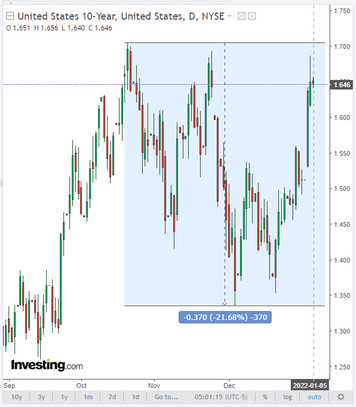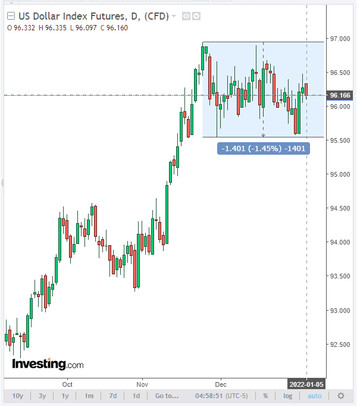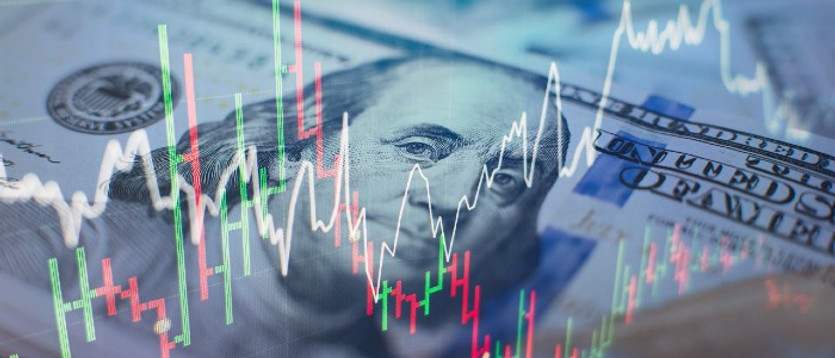Despite the fact that the New Year holidays for some investors and market participants are probably still going on, the tension in the financial market is growing. Yesterday the tone in the market was set by the Japanese yen, which was actively weakening throughout the entire trading day, and the USD / JPY pair reached an intraday high of 116.34 at the beginning of yesterday's American trading session, corresponding to the levels of January 2017.
While the number of new coronavirus cases is on the rise (the US had 1,083,948 new cases on Monday, according to Johns Hopkins University, a new record. The previous high of 486,428 cases was reached four days ago), investors it looks like they decided to ignore the risks associated with the coronavirus and sold the protective yen. The results of a survey of companies in the US manufacturing sector released on Monday showed that supply chain disruptions situation could start to improve. However, another report released on Tuesday by the Institute for Supply Management (ISM) showed that the pace of growth in US manufacturing activity slowed to its lowest level in 11 months, with the US manufacturing PMI at 58.7 in December, up from 61.1 in November against the forecast of 60.0 points.
At the same time, the number of Americans quitting in November reached a new high, while the number of vacancies remained near record levels. Published on Tuesday (at 15:00 GMT) November data on the number of open vacancies in the labor market from JOLTS turned out to be significantly worse than economists' expectations and the previous indicator (10.562 million vacancies against 11.091 million in October).
This data somewhat tempered investor optimism. Although the data released by ISM and the US Bureau of Labor Statistics still remains strong, they were below forecasts, which forced market participants to stop selling defensive assets. In the second half of yesterday's American trading session, the yen began to strengthen again, and gold quotes crawled upward, reaching $ 1814.00 per ounce by the end of yesterday's trading day. The yield on US 10-year bonds by the end of yesterday's trading day also declined from an intraday and 6-week high of 1.686% to 1.649%.

Today investors again prefer the protective yen, gold and government bonds to the dollar. The dollar fell during the Asian session and remains under pressure at the beginning of today's European session.
At the time of this posting, DXY dollar futures are traded near 96.16, just below the midpoint of the range between local highs near 96.94 and local lows near 95.54 in late November.
Nevertheless, if we abstract a little from the emergence of the omicron strain of the coronavirus, which in the past few weeks has led to an increase in the number of infections in Europe and the United States to record highs, forcing workers to leave offices and shoppers to refrain from shopping and restrict movement, then economists are more are optimistic about the prospects of the American economy, in comparison with other major economies in the world.
Very positive macro data continues to come from the USA. So, at the end of December, the US Bureau of Economic Analysis published the final estimate of the country's GDP dynamics for the 3rd quarter of 2021. It reflected the growth of the national economy by 2.3%, which is 0.2% better than previous preliminary estimates.
At the same time, the recently published weekly reports of the US Department of Labor with statistics on the number of unemployed indicate that the number of initial applications for unemployment benefits in the US remains at the lowest level in several decades - about 200 thousand. US consumer sentiment improved in December despite rising coronavirus infections and high inflation. Thus, the final consumer sentiment index in December was 70.6, which is higher than the preliminary value of 70.4 and the November value of 67.4.
Despite the currently observed correction, in general, the dollar retains positive dynamics and the potential for further growth. Markets believe the Fed will raise interest rates at least three times in 2022. The Fed will be ahead of other major banks in the world in this process, and this will be the main driver of the dollar strengthening in relation to its main competitors in the foreign exchange market.
Minneapolis Federal Reserve Bank President Neil Kashkari said Tuesday that inflation in the United States had exceeded forecasts and that the acceleration in price growth was longer than expected. Economists predict that the Fed will start raising rates this spring after the completion of the asset purchase program.
Therefore, looking at the DXY chart, DXY futures traders would likely place a buy stop just above the recent local high of 96.67 with a restrictive stop loss below the local low of 95.73. The nearest take-profit is 96.94, 97.00. The more distant DXY upside target is the 100.00 mark.

In an alternative scenario, the first signal to sell DXY futures would be a breakout of the important support level at 96.00, and a confirmatory signal would be a breakdown of the lower end of the range passing through the 95.54 mark.





